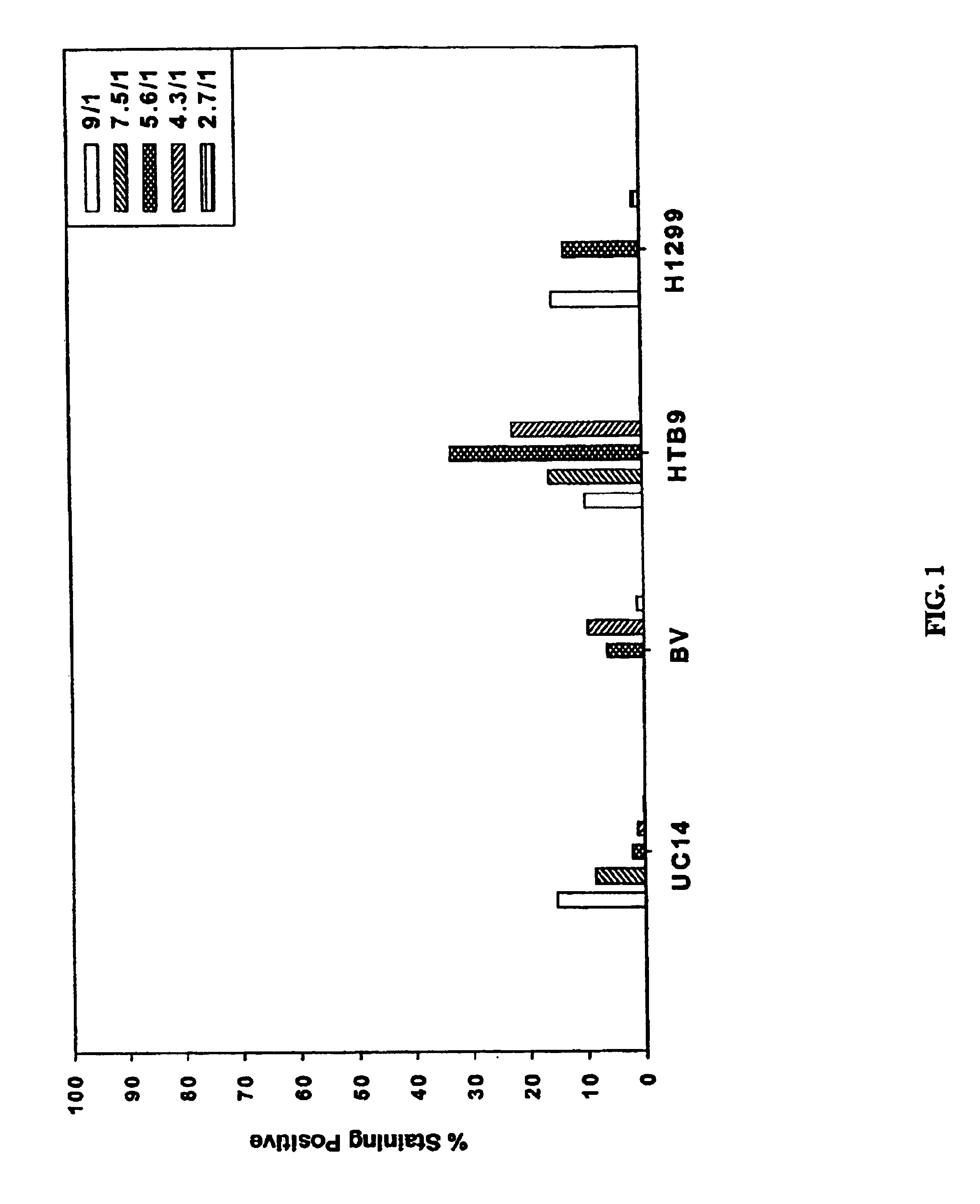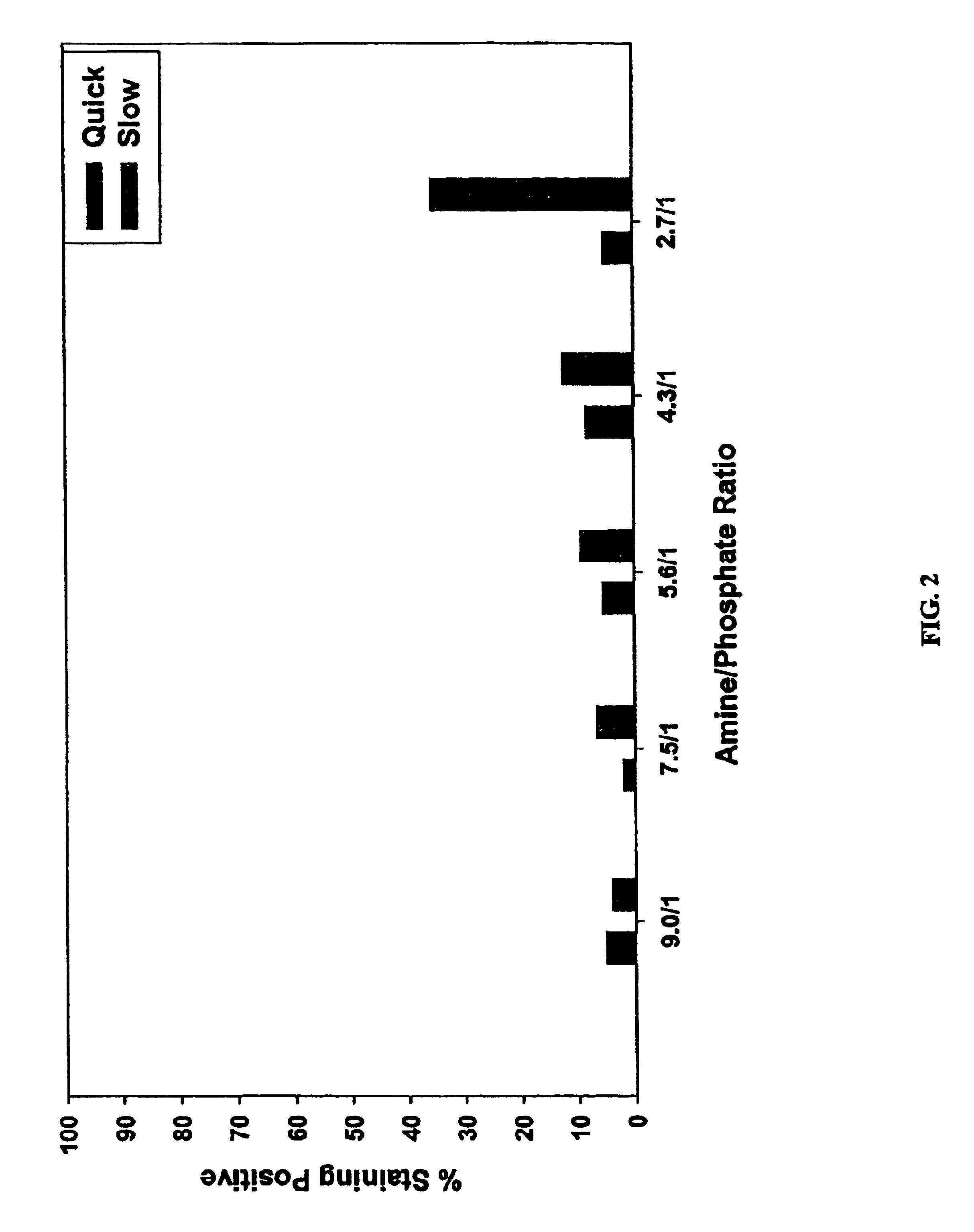PEI: DNA vector formulations for in vitro and in vivo gene delivery
a technology of dna vectors and in vivo gene delivery, applied in the field of nucleic acid transfection, can solve the problems of low level toxicity, inability to achieve the level of transduction obtained by most if not all viral and non-viral delivery compositions, and achieves simple structure, easy manipulation for targeting, and good suited for scale-up
- Summary
- Abstract
- Description
- Claims
- Application Information
AI Technical Summary
Benefits of technology
Problems solved by technology
Method used
Image
Examples
example 1
Transduction Analysis In Vitro Using Formula 1
Initially, studies utilizing PEI for nucleic acid delivery were designed to develope PEI as a backbone for targeted non-viral delivery composition formation using previous formulations (Bousiff et al., 1995; Boussif et al., 1996). This typically involved using equal volumes of PEI and DNA that are mixed together by either adding PEI to DNA or DNA to PEI. PEI (Sigma-Aldrich) was used and the plasmid DNA pCMV / β-gal, which comprises a cytomegalovirus enhancer / promoter driving E. coli β-galactosidase expression, was isolated using either Qiagen or Clontech endotoxin free DNA isolation kits. All DNA preparations were determined to be at less than 0.05 endotoxin units / μg DNA. The following mixing procedure termed “Formulation I” was used for the initial delivery composition formation:
Formulation I:
6 μg DNA in a volume of 30 μl of water was added to PEI in a volume of 30 μl of water, with continued vortexing. This method was used to produce con...
example 2
Transduction Analysis In Vitro Using Formula 2
Commercially available Qiagen and Clontech kits only produced DNA yields of 1-2 milligrams / liter of culture media. In addition, the Qiagen isolation kit often produced a white precipitate would co-purify with the DNA raising questions related to vector purity.
DNA was tested that was isolated using a new published procedure in which yields of >2-4 milligrams of DNA from 200 milliliters of initial bacterial culture could be obtained (Templeton et al., 1997). Once DNA was isolated using this new procedure, transduction was again examined on the same 4 cell lines.
In several of the studies, a surprising result was observed in which transduction levels in some samples using formulation I with DNA isolated from this new procedure would increase to much higher levels than in other samples. Several studies were performed comparing how the PEI and DNA were combined. One study in particular used the following procedure termed “Formulation II”:
Formu...
example 3
Transduction Analysis in vitro Using Formula 3
Formulation II did produce intermittent precipitation of the delivery composition upon delivery composition formation with some subsequent DNA preparations and that other types of plasmids also produced intermittent precipitation even though each had been isolated using the published protocol. DNA isolated from Qiagen and Clontech kits may not be suitable, and is thus less preferred, for this particular delivery composition formulation based on toxicity studies. However, the previous lack of problems associated with DNA isolated with the new procedure and the large DNA yield lead to a reduced number of DNA isolations for DNA production. To further clarify the various embodiments, the exact variable or variables that were needed to form an efficient delivery composition, irrelevant of slight variabilities in DNA quality, was reexamined.
The DNA isolated by Qiagen was compared to the new procedure in the analysis. A total of 10 different me...
PUM
| Property | Measurement | Unit |
|---|---|---|
| Fraction | aaaaa | aaaaa |
| Fraction | aaaaa | aaaaa |
| Fraction | aaaaa | aaaaa |
Abstract
Description
Claims
Application Information
 Login to View More
Login to View More - R&D
- Intellectual Property
- Life Sciences
- Materials
- Tech Scout
- Unparalleled Data Quality
- Higher Quality Content
- 60% Fewer Hallucinations
Browse by: Latest US Patents, China's latest patents, Technical Efficacy Thesaurus, Application Domain, Technology Topic, Popular Technical Reports.
© 2025 PatSnap. All rights reserved.Legal|Privacy policy|Modern Slavery Act Transparency Statement|Sitemap|About US| Contact US: help@patsnap.com



